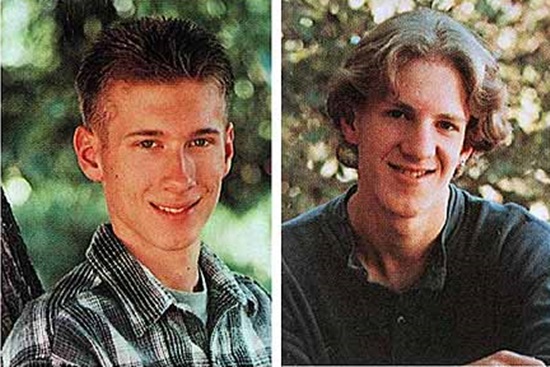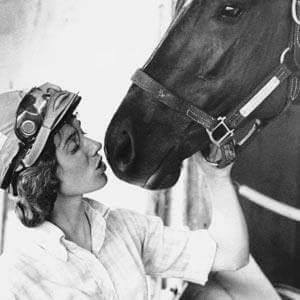Winner of the Spring 2018 StMU History Media Award for
Best Article in the Category of “United States History”
Best Descriptive Article
It was April 20, 1999 in Littleton Colorado. Seventeen-year-old Eric Harris and his eighteen-year-old friend Dylan Klebold both drove separately on a Tuesday morning to play a couple of frames of bowling before heading off to school. Before departing in their black trench coats, the teens stuffed their backpacks and two duffle bags into the trunk of their cars. When they arrived at their school campus later that morning, the two adolescents proceeded into the school, carrying the duffel bags, which contained two propane bombs.1 They kept the bombs inside the duffel bags and carried them into the cafeteria, setting up the bombs throughout the room, where they were rigged to detonate at precisely 11:17 AM. After setting up the bombs, Eric and Dylan then proceeded back to the school parking lot, where they waited for the bombs to explode. The boys had grave intentions on that day. Their intentions were to shoot up their high school, resulting in the most destructive school shooting to ever occur in the United States at the time. Their high school is known as Columbine, the most famous high school in America, for the wrong reasons.2

In January 1998, about a year before this horrific event unfolded, best friends Eric Harris and Dylan Klebold were suddenly surrounded by an aggressive and terrifying group of football players in the school cafeteria. The players proceeded to squirt ketchup packets at the two friends. Unable to fight back against the dominant jocks, Eric and Dylan were forced to wear their ketchup-stained clothes all day until they were able to go home from school. Around the cafeteria at Columbine, there were different classes of tables: the athletes had their table, and the weaker, outcast students had their table as well. While walking over to their table to sit at lunch, the athletes often threw skittles at Eric and Dylan and their outcast friends. While sitting at a lunch table with their few friends, the jocks kicked Eric and Dylan’s chairs, knocked their food trays down, and lunged food at them in the cafeteria. Bullying was not only a common occurrence to Eric and Dylan, but it also occurred to other students as well. Weaker students were shoved into lockers, called vile names, and also body slammed. They were the targets of the predators of the school. Everyone in the school, including Eric and Dylan, were afraid of the intimidating jocks, and for good reason. They were members of the trench coat mafia, which was a group that the two teens belonged to, which consisted of pro-Nazi outcasts, such as Eric and Dylan, and who also held a strong hatred for Christians. Their other trench coat mafia friends were able to shrug off the constant bullying. However, the same cannot be said about Eric and Dylan. The two friends took it in and absorbed it all, and their anger grew.3
As a result of the relentless harassment throughout Columbine, before going on a school-wide mass shooting spree, Eric Harris decided to dose on cough syrup, which he said, “is the best thing after a hard day of being called ‘gay’ by a schoolyard full of fashionable jocks and cheerleaders.”4 The two boys were outcasts of their school and members of this trench coat mafia subculture. At lunch for weeks, Eric and Dylan fantasized about blowing up the school, but because being harassed at Columbine was so common for outcast students, it was not unusual for students to speak of such outlandish events. So, when Eric and Dylan said this, other students did not believe they were serious; however, the intentions of the two teens were indeed grim and were not to be underestimated.5
The constant hatred towards his peers caused Eric to devise the plan of the shooting of his high school. Eric did most of the planning, while Dylan followed his lead and did what he said. Eric went into the cafeteria and observed when it was the most populated. He discovered that there were around 488 people inside the cafeteria at 11:17 a.m. Since this was the most populated time, they planned to bring two black duffel bags, each containing a propane tank that they would rig to explode at 11:17 a.m. In addition, they bought weapons, made bombs, and hid them in their trench coats and in the trunks of their cars. They carefully planned the terrible act for over a year prior to the shooting.6
After months and months of constant planning, Eric and Dylan were ready to put their diabolical plan into action. On April 20, 1999, around 11:20 AM, after placing the bombs in the cafeteria, Eric and Dylan were most likely bored of waiting in the parking lot for the bombs to explode. After the bombs failed to detonate around that time, the two adolescents began the destruction of their high school. They unzipped their trench coats, pulled out their guns, and opened fire in the parking lot of Columbine.7

Outside of the school building on campus, seventeen-year-old Rachel Scott was eating lunch with her friend Richard Castaldo. Eric and Dylan came up to Rachel and Richard. The two shooters shot Richard multiple times in almost every part of his body, including his lungs. Then, they shot Rachel several times, hitting her thigh, left arm, and chest. They then turned their guns towards other fleeing students, shooting them as well. Rachel Scott laid on the ground, crying. Rachel, like many other victims of the shooting, was a Christian, which was the religion that the two pro-Nazi shooters despised. Eric went up to the poor and helpless Christian, and asked, “Do you believe in God?” Rachel said yes, and in response Eric said, “Then go be with Him,” and he shot her once again killing her.8 Rachel Scott died a martyr on that horrific day for her faith. Eric and Dylan resumed their carnage by entering into the school building itself. They went into the cafeteria, where most of the students had evacuated. While searching for students, the shooters began throwing bombs. Eric and Dylan then headed upstairs in the building. Coach Dave Sanders decided to stay back in the school to aid students, when Eric and Dylan ran into him. They shot Sanders in the back while he was fleeing, killing him instantly. After combing through the cafeteria, the shooters entered the library of Columbine, the deadliest room of the shooting. They began the bloodshed in the library by shooting behind the librarian’s desk. While in the commons, Eric and Dylan were taunting the students, yelling at them and cursing. They shouted at the horrified teens yelling, “All the jocks stand up!” They also targeted students who were wearing sports apparel. Isaiah Shoels was in the library on that nightmarish day. Isaiah was a football player at the school, which was not a good position to be in on April 20, 1999 at Columbine. Due to his African-American race, Eric and Dylan yelled racial slurs at Isaiah, and then they shot him. Unfortunately, there was more blood to be spilled. Eric then made his way towards Cassie Bernall, another Christian at Columbine, and asked her, “Do you believe in God”? Once again, just like Rachel Scott, Cassie firmly responded “yes,” and then they killed her. Just like Rachel Scott, Cassie Bernall became a martyr at the hands of Eric Harris while professing her faith. They did the same Christian interrogation to Val Schnurr, who admitted her faith and was killed for it. The outraged gunmen exited the commons, leaving ten students in the library shot in cold blood, and many others injured.9

While roaming the school, the campus was being surrounded by police, ambulances, and even the National Guard. They knew they were not leaving that building alive. After deciding that there was nowhere else to run, Eric Harris and Dylan Klebold returned to the library, where they shot themselves in the head, putting an end to the bloody massacre of Columbine High School.10
The suicide of Eric Harris and Dylan Klebold may have seemed like a definite conclusion to the horrific shooting for some; however, for others, it was only just the beginning. Many families of those slaughtered victims at Columbine could not even begin to comprehend the weight of the situation. Many parents, whose sons or daughters became victims of the shooting, feared for their own marriages, let alone their mental status. One mother of one of the injured victims of the shooting committed suicide years later, due to her daughter being paralyzed and forced into a wheelchair for the rest of her life.11 However, despite the catastrophes of the families, to Eric and Dylan, this was a major success. They planned everything from entering the building, all the way to their own deaths. Eric Harris and Dylan Klebold were constantly harassed both physically and verbally to the point where they could no longer absorb any more humiliation and mistreatment from their peers. The constant bullying that the adolescents endured resulted in them dealing with severe depression disorders that few people were aware of. Even Dylan’s own parents were unaware of his suicidal behavior and of his ongoing depression at Columbine. Several arguments can be made about the cause of Columbine and what was truly going on inside the teens’ heads. Many claim the cause of the shooting was bullying, while others claim the shooting to be caused by the influence of violent video games, like “Doom,” and goth music artists, like Marilyn Manson. Whatever the true intentions of Eric and Dylan were, we will never seem to understand entirely. However, one point can be made about the disastrous shooting of Columbine on that horrid day. Eric Harris and Dylan Klebold had a specific goal: to exact revenge on the students of Columbine High School.
- UXL Encyclopedia of U.S. History, 2009, s.v. “Columbine High School Shooting,” by Sonia Benson. ↵
- American Decades, 2004, s.v. “Analysis: What the Two Young Colorado Gunmen Were Really Like,” by Cynthia Rose. ↵
- Perspectives on Modern World History, 2012, s.v. “Columbine High School Had a Serious Bullying Problem,” by Ralph W. Larkin. ↵
- Perspectives on Modern World History, 2012, s.v. “Columbine High School Had a Serious Bullying Problem,” by Ralph W. Larkin. ↵
- Ralph W. Larkin, Comprehending Columbine (Philadelphia: Temple University Press, 2007), 131. ↵
- Ralph W. Larkin, Comprehending Columbine (Philadelphia: Temple University Press, 2007), 131. ↵
- Wendy Murray Zoba, “Do you Believe in God?” Christianity Today, October 1999. ↵
- Life Focus, “Rachel Scott Life Focus Documentary”, 12:45-13:24, February 15 2016, https://www.youtube.com/watch?v=7M6MSM9o5Y4. ↵
- Wendy Murray Zoba, “Do you Believe in God?” Christianity Today, October 1999. ↵
- Wendy Murray Zoba, “Do you Believe in God?” Christianity Today, October 1999. ↵
- US News and World Report, “Columbine Shooting: 10 Years Later,” 0:00-3:39, April 19, 2009, https://www.youtube.com/watch?v=5XTIOs4YK_c. ↵



239 comments
Michael Thomas
I found this article interesting because of how it details the events of the Columbine massacre and the theories of what led to the boys killing the students. Dylan Klebold and Eric Harris were bullied by the athletes at Columbine and were viewed as the outcasts. They wanted vengeance on those who had bullied them. Their plan for the mass shooting was to distract emergency responders and law enforcement, which gave them time to go on their rampage. With the time they had to go on their killing spree, they wandered the school finding people to kill and exact their vengeance on. Overall, this article was good, informative, and well-written.
Constancia Tijerina
This article may seem as overrated and burnt out, yet this article speaks out the most even for the most recent events that still occur till to this day. This article sets an example to how our system stays the same; history yet again repeating itself. Its amazing to me how this article alone stands out towards what is most important now in our society and how these tragic events should never happen again. Great article.
Monica Avila
This massacre was truly horrifying for not only the families of the victims, but also for the Americans across the country who received news of this atrocity. Whatever was going through these young boys’ heads, I can not even fathom to think of. This tragedy will forever follow our history, and remains prevalent even today, in light of the many massacres that occur every year, if not, every month.
Vanessa Tombo
The writer’s diction, syntax, tone and most importantly colorful images made this article very easy to read, understand and enjoy for me. Prior to reading this article, I was not familiar with details of “The Massacre at Columbine”. I like how the article talks about mental health and how the boys had been bullied by their peers. Mental abuse is one of the worst abuse, it can make the victim consider harming themselves or others as a way of releasing their pain.
Elias Garza
It is sad to realize how much impact this event has had in history, and we seem to not learn from it. There are so many cases of gun violence in schools from minors. There should be something done about it is just such an important issue now a days and its so sad who we don’t pay attention to how history seems to be repeating itself over and over again. Although it is interesting to read in this article some patterns that you can find in this cases.
Esperanza Mauricio
Although this event is a great tragedy it is nice to have an article dedicated to it. Younger people sometimes do not know about our history of gun violence and over look past events such as this one. I had this conversation with one of my younger neighbors who did not know anything about this event and only took notice of recent cases of gun violence in schools. She was shocked to learn about this event. I am although saddened by the Columbine shooting it is crucial to the history of gun violence and its horrors.
Erin Vento
I know everybody probably thought this while reading the article, but this is such a relevant and important event in recent history that continues to affect us. There have more mass shootings than ever; with guns available and easily obtainable and the social climate right now, articles like this should show us that it been a time for change. Really good job.
Samire Adam
One of the best article I have read by far. I was captivated by the way in which the writer chose to write this horrific event. It was very well organized as it included all the boys activities in chronological order from the moment they got to school to the end when they took their own lives soon after committing the most destructive school shooting at the time.
Maria Mancha
Reading this Article at the beginning of the Semester I was extremely fascinated by it and reading it again now I still am. The pain these boys caused not only students but they’re families are ones that will last forever. I think this article is such an important read because you never think it can happen to you, by someone you knew or even thought you knew. The horrible day will be marked in history forever. Amazing article Tim and this article truly deserved its nomination.
Christopher King
I enjoyed this article very much. I liked that the story was told as what had happened and avoided any biased views. I hate to see that those two students were subject to so much bullying that it drove them to kill so many kids just so they can have their revenge. Unfortunately, it can still be seen today and for some reason keeps repeating itself. The article takes you through what happened and with questions that they asked you feel tense and emotional for those students killed. This has been one of my favorite article so far that I have read this semester.